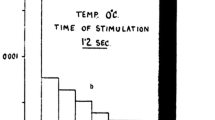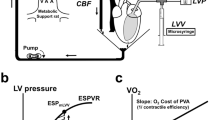Abstract
Using metal-film thermopiles, heat production of isolated rabbit papillary muscles was measured under aerobic conditions at 20°C. The time course of total heat production resulting from a single contraction (average of 10) and a twitch train of 10 contractions (0.2 Hz) was separated into initial (I) and recovery heart (R). The time course of recovery heat production of single twitches was characterized by a time constant of 25.4±1.7 s (mean±SE;n=10). The recovery ratio,R/I, was 1.18±0.08 (mean±SE;n=7). Total heat produced 25.2±2.9mJ·g −1dw (mean±SE;n=11). After trains of 10 contractions a time constant of 25.2±1.6 s (mean±SE;n=9) was found. The recovery ratio was 1.14±0.09 (mean±SE;n=9). Total heat produced was 489±41 mJ·g −1dw (mean±SE;n=9). Time constants and recovery ratios for 1 and 10 twitches were not significantly different. This suggests that only the extent but not the nature of the chemical processes after contraction changes when the preparation produces about 20 times more heat. Since the recovery ratio values did not differ largely from the value derived theoretically the conclusion is justified that, under normal aerobic conditions, PCr splitting and its oxidative resynthesis are the major metabolic processes responsible for the energy supply of isolated cardiac muscle.
Similar content being viewed by others
References
Alpert NR, Mulieri LA (1982) Increased myothermal economy of isometric force generation in compensated cardiac hypertrophy induced by pulmonary artery constriction in the rabbit. A characterization of heat liberation in normal and hypertrophied right ventricular papillary muscles. Circ Res 50:491–500
Bugnard L (1934) The relation between total and initial heat in single muscle twitches. J Physiol 82:509–519
Carslaw HS, Jaeger JC (1959) Conduction of heat in solids. Oxford University Press, Oxford, pp 130–131
Chapman JB (1972) Fluorometric studies of oxidative metabolism in isolated papillary muscle of the rabbit. J Gen Physiol 59: 135–154
Chapman JB, Gibbs CL (1974) The effect of metabolic substrate on mechanical activity and heat production in papillary muscle. Cardiovasc Res 8:656–667
Crow MT, Kushmerick MJ (1982) Chemical energetics of slow-and fast-twitch muscles of the mouse. J Gen Physiol 79:147–166
Curtin NA, Woledge RC (1978) Energy changes and muscular contraction. Physiol Rev 58:690–761
Dijkema FK, Elzinga G, Holewijn AJ (1985) Measurement of temperature changes in muscle contraction with a thermopile and amplifier designed to improve signal-to-noise ratio and resolution in time and place. J Physiol 366:4P
Elzinga G, Langewouters GJ, Westerhof N, Wiechmann AHCA (1984) Oxygen uptake of frog skeletal muscle fibers following tetanic contractions at 18°C. J Physiol 346:365–377
Gibbs CL (1969) The energy output of normal and anoxic cardiac muscle. In: McCann FV (ed) Comparative physiology of the heart: Current trends. Birkhäuser, Basel, p 78
Gibbs CL (1978) Cardiac energetics. Physiol Rev 58:174–254
Godfraind-de Becker A (1971) The ratio of oxidative recovery heat to initial heat in toad sartorius. J Physiol 217:63P-64P
Godfraind-de Becker A (1972). Heat production and fluorescence changes of toad sartorius muscle during aerobic recovery after a short tetanus. J Physiol 223:719–734
Hill AV, Kupalov PS (1930) The vapour pressure of muslce. Proc R Soc [B] 106:445–477
Hill AV (1965) The recovery heat production in oxygen: quantities. In: Trails and trials in physiology, chap 4. Arnold, London, pp 178–188
Hill DK (1940a) The time course of the oxygen consumption of stimulated frog's muscle. J Physiol 98:207–227
Hill DK (1940b) The time course of evolution of oxidative recovery heat of frog's muscle. J Physiol 98:454–459
Holubarsch Ch, Goulette RP, Litten RZ, Martin BJ, Mulieri LA, Alpert NR (1985) The economy of isometric force development, myosin isoenzyme pattern and myofibrillar ATPase activity in normal and hypothyroid rat myocardium. Circ Res 56:78–86
Kretzschmar KM, Wilkie DR (1972) A new method for absolute heat measurements, utilizing the Peltier effect. J Physiol 224: 18P-20P
Kushmerick MJ (1983) Energetics of muscle contraction. In: Peachey LD, Adrian RH, Geiger SR (eds) Handbook of Physiology, Section 10: Skeletal muscle. American Physiological Society, Bethesda MD, pp 189–236
Kushmerick MJ, Paul RJ (1976) Aerobic recovery metabolism following a single isometric tetanus in frog sartorius muscle at 0°C. J Physiol 254:693–709
Loiselle DS (1985) The rate of resting heat production of rat papillary muscle. Pflügers Arch 405:155–162
Mahler M, Louy C, Homsher E, Peskoff A (1985) Reappraisal of diffusion, solubility, and consumption of oxygen in frog skeletal muscle, with applications to muscle energy balance. J Gen Physiol 86:105–134
Marquardt DW (1963) An algorithm for least-squares estimation of nonlinear parameters. J Soc Indust Appl Math 11:431–441
Mast F, Elzinga G (1987a) Time course of aerobic recovery following contraction of rabbit papillary muscle. Am J Physiol 253:H325-H332
Mast F, Elzinga G (1987b) Heat production and oxygen consumption following contraction of isolated rabbit papillary muscle at 20°C. Basic Res Cardiol 82 (Suppl 2):85–92
Mulieri LA, Luhr G, Trefry J, Alpert NR (1977) Metal-film thermopiles for usage with rabbit right ventricular papillary muscles. Am J Physiol 233:C146-C156
Ricchiuti NV, Gibbs CL (1965) Heat production in a cardiac contraction. Nature 208:897–898
Woledge RC, Curtin NA, Homsher E (1985) Energetic aspects of muscle contraction. Academic Press, London, p 219
Author information
Authors and Affiliations
Rights and permissions
About this article
Cite this article
Mast, F., Elzinga, G. Recovery heat production of isolated rabbit papillary muscle at 20°C. Pflugers Arch. 411, 600–605 (1988). https://doi.org/10.1007/BF00580854
Received:
Revised:
Accepted:
Issue Date:
DOI: https://doi.org/10.1007/BF00580854




